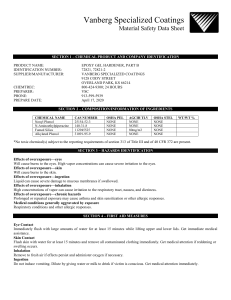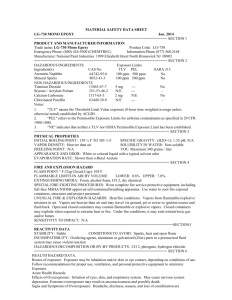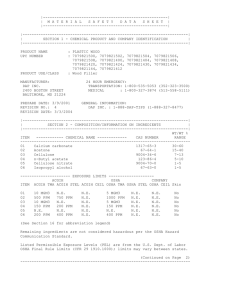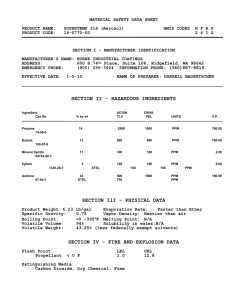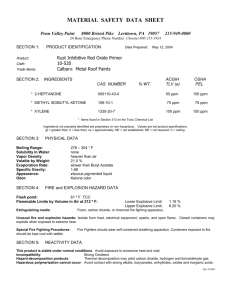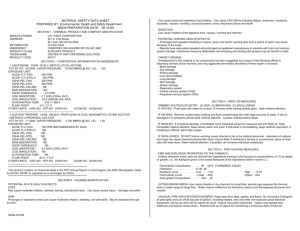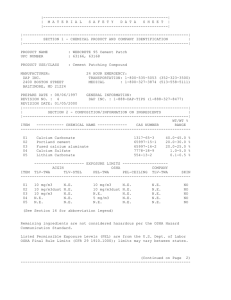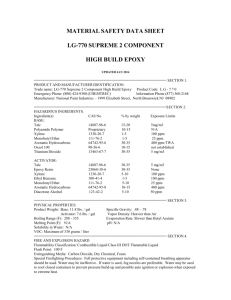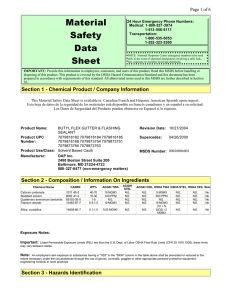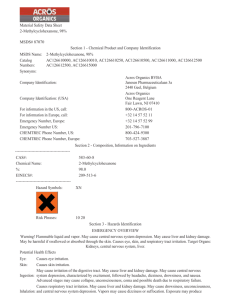|-------------------------------------------------------| | M A T E R I A L ...
advertisement
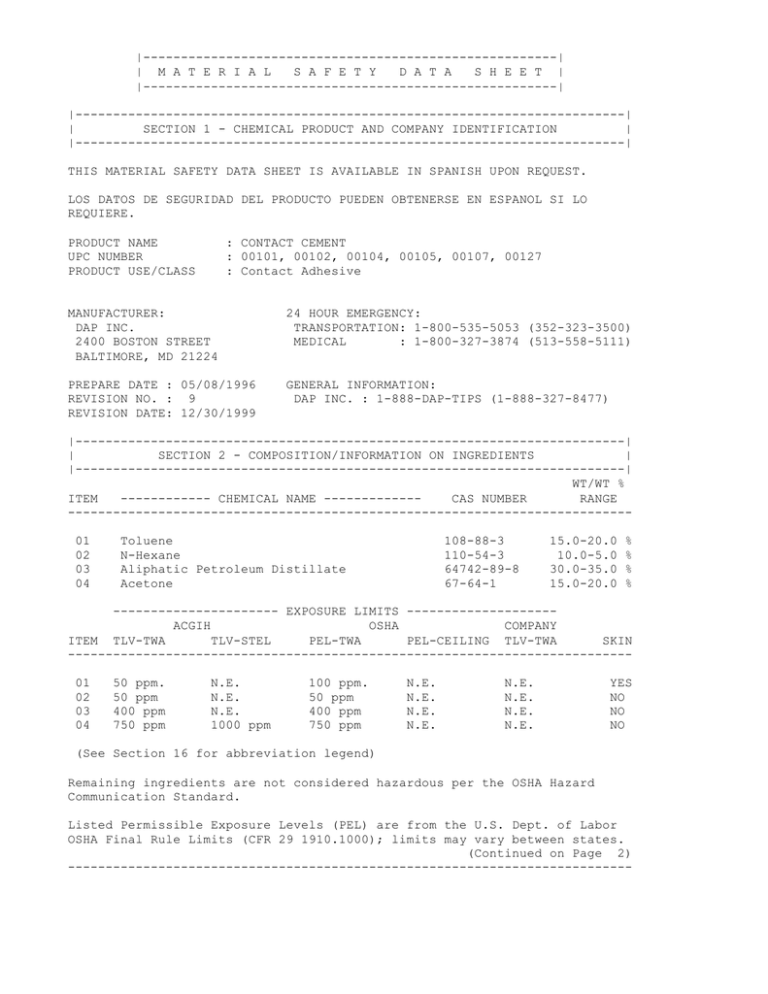
|-------------------------------------------------------| | M A T E R I A L S A F E T Y D A T A S H E E T | |-------------------------------------------------------| |-------------------------------------------------------------------------| | SECTION 1 - CHEMICAL PRODUCT AND COMPANY IDENTIFICATION | |-------------------------------------------------------------------------| THIS MATERIAL SAFETY DATA SHEET IS AVAILABLE IN SPANISH UPON REQUEST. LOS DATOS DE SEGURIDAD DEL PRODUCTO PUEDEN OBTENERSE EN ESPANOL SI LO REQUIERE. PRODUCT NAME UPC NUMBER PRODUCT USE/CLASS : CONTACT CEMENT : 00101, 00102, 00104, 00105, 00107, 00127 : Contact Adhesive MANUFACTURER: DAP INC. 2400 BOSTON STREET BALTIMORE, MD 21224 24 HOUR EMERGENCY: TRANSPORTATION: 1-800-535-5053 (352-323-3500) MEDICAL : 1-800-327-3874 (513-558-5111) PREPARE DATE : 05/08/1996 REVISION NO. : 9 REVISION DATE: 12/30/1999 GENERAL INFORMATION: DAP INC. : 1-888-DAP-TIPS (1-888-327-8477) |-------------------------------------------------------------------------| | SECTION 2 - COMPOSITION/INFORMATION ON INGREDIENTS | |-------------------------------------------------------------------------| WT/WT % ITEM ------------ CHEMICAL NAME ------------CAS NUMBER RANGE --------------------------------------------------------------------------01 02 03 04 Toluene N-Hexane Aliphatic Petroleum Distillate Acetone 108-88-3 110-54-3 64742-89-8 67-64-1 15.0-20.0 10.0-5.0 30.0-35.0 15.0-20.0 % % % % ---------------------- EXPOSURE LIMITS -------------------ACGIH OSHA COMPANY ITEM TLV-TWA TLV-STEL PEL-TWA PEL-CEILING TLV-TWA SKIN --------------------------------------------------------------------------01 02 03 04 50 ppm. 50 ppm 400 ppm 750 ppm N.E. N.E. N.E. 1000 ppm 100 ppm. 50 ppm 400 ppm 750 ppm N.E. N.E. N.E. N.E. N.E. N.E. N.E. N.E. YES NO NO NO (See Section 16 for abbreviation legend) Remaining ingredients are not considered hazardous per the OSHA Hazard Communication Standard. Listed Permissible Exposure Levels (PEL) are from the U.S. Dept. of Labor OSHA Final Rule Limits (CFR 29 1910.1000); limits may vary between states. (Continued on Page 2) --------------------------------------------------------------------------- Product Name: CONTACT CEMENT Revision Date: 12/30/1999 Page 2 |-------------------------------------------------------------------------| | SECTION 3 - HAZARDS IDENTIFICATION | |-------------------------------------------------------------------------| EMERGENCY OVERVIEW: DANGER! Extremely flammable liquid and vapor. Vapor harmful. Vapors may cause flash fire or explosion. Aspiration hazard if swallowed - can enter lungs and cause damage. Harmful if inhaled. POTENTIAL HEALTH EFFECTS: EFFECTS OF OVEREXPOSURE - EYE CONTACT: May cause eye irritation. EFFECTS OF OVEREXPOSURE - SKIN CONTACT: May irritate skin. Prolonged or repeated contact can result in defatting and drying of the skin which may result in skin irritation and dermatitis (rash). EFFECTS OF OVEREXPOSURE - INHALATION: Vapor harmful if inhaled. Vapor may irritate nose and upper respiratory tract. Vapor inhalation may affect the brain or nervous system causing dizziness, headache or nausea. EFFECTS OF OVEREXPOSURE - INGESTION: Aspiration of material into the lungs due to vomiting can cause chemical pneumonitis which can be fatal. If ingested, this product may cause vomiting, diarrhea, and depressed respiration. EFFECTS OF OVEREXPOSURE - CHRONIC HAZARDS: Reports have associated permanent brain and nervous system damage with prolonged and repeated occupational overexposure to solvents. Overexposure or misuse of toluene can cause liver, kidney, and brain damage as well as cardiac abnormalities. Hexane exposure can cause nerve damage to arms and legs which may permanent. Symptoms include: loss of memory, loss of intellectual ability, and loss of coordination. MEDICAL CONDITIONS WHICH MAY BE AGGRAVATED BY CONTACT: PRIMARY ROUTE(S) OF ENTRY: SKIN CONTACT None known. INHALATION |-------------------------------------------------------------------------| | SECTION 4 - FIRST AID MEASURES | |-------------------------------------------------------------------------| EYE CONTACT: subsides. SKIN CONTACT: Flush with large quantities of water until irritation Wash with soap and water. INHALATION: Remove to fresh air. If not breathing, give artificial respiration. If breathing is difficult, give oxygen. (Continued on Page 3) --------------------------------------------------------------------------- Product Name: CONTACT CEMENT Revision Date: 12/30/1999 Page 3 |-------------------------------------------------------------------------| | SECTION 4 - FIRST AID MEASURES | |-------------------------------------------------------------------------| INGESTION: DO NOT INDUCE VOMITING. COMMENTS: Call Medical in Section 1 if irritation or complications arise from any of the above routes of exposure. |-------------------------------------------------------------------------| | SECTION 5 - FIRE FIGHTING MEASURES | |-------------------------------------------------------------------------| FLASH POINT: -50 F (SETAFLASH CLOSED CUP) LOWER EXPLOSIVE LIMIT: N.A. UPPER EXPLOSIVE LIMIT: N.A. AUTOIGNITION TEMPERATURE: N.E. EXTINGUISHING MEDIA: CO2 DRY CHEMICAL FOAM UNUSUAL FIRE AND EXPLOSION HAZARDS: Extremely flammable. Material will readily ignite at room temperature. Vapors may form an explosive mixture with air. Vapors can travel through a source of ignition and flashback. Containers may explode if exposed to extreme heat. Eliminate sources of ignition: heat, electrical equipment, sparks, and flames. Do not put in contact with oxidizing or caustic materials. SPECIAL FIREFIGHTING PROCEDURES: Full protective equipment, including self-contained breathing apparatus, is recommended to protect from combustion products. Cool exposed containers with water. |-------------------------------------------------------------------------| | SECTION 6 - ACCIDENTAL RELEASE MEASURES | |-------------------------------------------------------------------------| SPILL OR LEAK PROCEDURES: Dike spill area. Immediately eliminate sources of ignition. Use absorbent material or scrape up dried material and place into containers. |-------------------------------------------------------------------------| | SECTION 7 - HANDLING AND STORAGE | |-------------------------------------------------------------------------| HANDLING INFORMATION: KEEP OUT OF REACH OF CHILDREN. Avoid skin and eye contact. Avoid breathing vapors. Use only in a well ventilated area. STORAGE INFORMATION: Store away from caustics and oxidizers. Keep away from heat, spark, and flame. Keep containers tightly closed when not in use. Keep containers from excessive heat and freezing. Do not store at temperatures above 120 degrees F. (Continued on Page 4) --------------------------------------------------------------------------- Product Name: CONTACT CEMENT Revision Date: 12/30/1999 Page 4 |-------------------------------------------------------------------------| | SECTION 7 - HANDLING AND STORAGE | |-------------------------------------------------------------------------| OTHER PRECAUTIONS: Intentional misuse by deliberately concentrating and inhaling vapors may be harmful or fatal. Do not take internally. Construction and repair activities can adversely affect indoor air quality. Consult with the occupants or a representative(i.e. maintenance, building manager, industrial hygienist, or safety officer) to determine ways to minimize any impact. |-------------------------------------------------------------------------| | SECTION 8 - EXPOSURE CONTROLS/PERSONAL PROTECTION | |-------------------------------------------------------------------------| ENGINEERING CONTROLS: Provide sufficient mechanical ventilation (local or general exhaust) to maintain exposure below PEL and TLV. Vapors are heavier than air and will collect in low areas. Check all low areas (basements, sumps, etc.) for vapors before entering. RESPIRATORY PROTECTION: If 8 hour exposure limit or value is exceeded for any component, use an approved NIOSH respirator. Consult your safety equipment supplier and the OSHA regulation, 29 CFR 1910.134 for respirator requirements. A respiratory protection program that meets OSHA 1910.134 and ANSI Z88.2 requirements must be followed whenever workplace conditions warrant a respirator's use. EYE PROTECTION: SKIN PROTECTION: Goggles or safety glasses with side shields. Solvent impervious gloves. OTHER PROTECTIVE EQUIPMENT: if body contact may occur. HYGIENIC PRACTICES: Provide eyewash and solvent impervious apron Remove contaminated clothing and wash before reuse. |-------------------------------------------------------------------------| | SECTION 9 - PHYSICAL AND CHEMICAL PROPERTIES | |-------------------------------------------------------------------------| BOILING RANGE ODOR APPEARANCE SOLUBILITY IN H2O SPECIFIC GRAVITY VAPOR PRESSURE PHYSICAL STATE : : : : : : : 130 - 140 F VAPOR DENSITY : Is heavier than air Gasoline-like Tan mobile liquidEVAPORATION RATE: Is faster than Butyl Negligible Acetate 0.8040 400 mm Hg @ 100 F. Liquid (See Section 16 for abbreviation legend) |-------------------------------------------------------------------------| | SECTION 10 - STABILITY AND REACTIVITY | |-------------------------------------------------------------------------| CONDITIONS TO AVOID: INCOMPATIBILITY: Excessive heat and freezing. Strong oxidizers and caustics. (Continued on Page 5) --------------------------------------------------------------------------- Product Name: CONTACT CEMENT Revision Date: 12/30/1999 Page 5 |-------------------------------------------------------------------------| | SECTION 10 - STABILITY AND REACTIVITY | |-------------------------------------------------------------------------| HAZARDOUS DECOMPOSITION PRODUCTS: NOx Normal decomposition products, i.e. COx, HAZARDOUS POLYMERIZATION: Will not occur under normal conditions. STABILITY: This product is stable under normal storage conditions. |-------------------------------------------------------------------------| | SECTION 11 - TOXICOLOGICAL PROPERTIES | |-------------------------------------------------------------------------| No product or component toxicological information is available. |-------------------------------------------------------------------------| | SECTION 12 - ECOLOGICAL INFORMATION | |-------------------------------------------------------------------------| No Information. |-------------------------------------------------------------------------| | SECTION 13 - DISPOSAL CONSIDERATIONS | |-------------------------------------------------------------------------| WASTE MANAGEMENT/DISPOSAL: Dispose of according to Federal, State, and Local Standards. Discarded material should be incinerated at a permitted facility. Liquids cannot be disposed of in a landfill. Do not reuse empty container. State and Local regulations/restrictions are complex and may differ from Federal regulations. Responsibility for proper waste disposal is with the owner of the waste. EPA WASTE CODE - If discarded (40 CFR 261): D001-Ignitable. |-------------------------------------------------------------------------| | SECTION 14 - TRANSPORTATION INFORMATION | |-------------------------------------------------------------------------| DOT PROPER SHIPPING NAME: Adhesive(Consumer Commodity*) DOT HAZARD CLASS: 3(ORM-D*) DOT UN/NA NUMBER: UN 1133(NONE*) PACKING GROUP: II(NONE*) * For containers of 1 gallon or less. |-------------------------------------------------------------------------| | SECTION 15 - REGULATORY INFORMATION | |-------------------------------------------------------------------------| U.S. FEDERAL REGULATIONS: AS FOLLOWS OSHA: Hazardous by definition of Hazard Communication Standard (29 CFR 1910.1200) (Continued on Page 6) --------------------------------------------------------------------------- Product Name: CONTACT CEMENT Revision Date: 12/30/1999 Page 6 |-------------------------------------------------------------------------| | SECTION 15 - REGULATORY INFORMATION | |-------------------------------------------------------------------------| SARA SECTION 313: This product contains the following substances subject to the reporting requirements of Section 313 of Title III of the Superfund Amendments and Reauthorization Act of 1986 and 40 CFR Part 372: ----------- CHEMICAL NAME ----------Toluene N-Hexane CAS NUMBER 108-88-3 110-54-3 WT/WT % RANGE 15.0-20.0 % 10.0-15.0 % TOXIC SUBSTANCES CONTROL ACT: This product contains the following chemical substances subject to the reporting requirements of TSCA 12(B) if exported from the United States: ----------- CHEMICAL NAME ----------No information is available. CAS NUMBER NEW JERSEY RIGHT-TO-KNOW: The following materials are non-hazardous, but are among the top five components in this product: ----------- CHEMICAL NAME ----------Polychlorinated Rubber CAS NUMBER TSRN-618608-5001P PENNSYLVANIA RIGHT-TO-KNOW: The following non-hazardous ingredients are present in the product at greater than 3%: ----------- CHEMICAL NAME ----------Polychlorinated Rubber Phenolic resin Polychlorinated Rubber CAS NUMBER proprietary proprietary proprietary CALIFORNIA PROPOSITION 65: WARNING: The chemical(s) noted below and contained in this product, are known to the state of California to cause birth defects or other reproductive harm: ----------- CHEMICAL NAME ----------Toluene CAS NUMBER 108-88-3 INTERNATIONAL REGULATIONS: AS FOLLOWS CANADIAN WHMIS: This MSDS has been prepared in compliance with Controlled Product Regulations except for use of the 16 headings. CANADIAN WHMIS CLASS: Consumer Commodity sold on retail market only. (Continued on Page 7) --------------------------------------------------------------------------- Product Name: CONTACT CEMENT Revision Date: 12/30/1999 Page 7 |-------------------------------------------------------------------------| | SECTION 16 - OTHER INFORMATION | |-------------------------------------------------------------------------| HMIS RATINGS - HEALTH: 2 FLAMMABILITY: 3 REACTIVITY: 0 PREVIOUS MSDS REVISION DATE: 02/01/1997 REASON FOR REVISION: SECTION 1: Address change and new emergency contact phone numbers. VOC less water, less exempt solvent: 600-610 gm/l(75-76%)where acetone is exempt VOC material: 490-500 gm/l(61-62%) LEGEND: ACGIH N.A. N.E. PEL NTP SARA STEL TLV VOC NJRTK N.D. - AMERICAN CONFERENCE OF GOVERNMENTAL INDUSTRIAL HYGIENISTS NOT APPLICABLE NOT ESTABLISHED PERMISSIBLE EXPOSURE LIMIT NATIONAL TOXICOLOGY PROGRAM SUPERFUND AMENDMENTS AND REAUTHORIZATION ACT OF 1986 SHORT TERM EXPOSURE LIMIT THRESHOLD LIMIT VALUE(8 HR. TIME WEIGHTED AVERAGE OR TWA) VOLATILE ORGANIC COMPOUND NEW JERSEY RIGHT TO KNOW LAW NOT DETERMINED MSDS# 30202 --------------------------------------------------------------------------- This data is offered in good faith as typical values and not as a product specification. No warranty either expressed or implied, is hereby made. The recommended industrial hygiene and safe handling procedures are believed to be generally applicable. However, each user should review the recommendations in specific context of the intended use and determine if they are appropriate. --------------------------------------------------------------------------< End OF MSDS >
